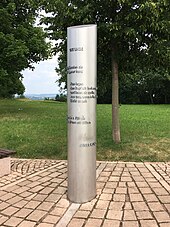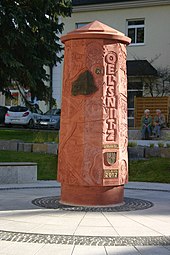List of works of art in public space in Oelsnitz / Erzgeb.
This list gives an overview of the works of art in public space in Oelsnitz / Erzgeb. in Saxony . In the last few decades, a contemporary artistic examination of historical-economic and artistic history has taken place in the city. Ideas were developed and works of art realized in various projects and competitions. Historical works of art such as B. the Hermann-Rudolph-Brunnen , which has already entered the list of cultural monuments in Oelsnitz / Erzgeb. found there.
Art in public space
| image | Artwork / location | Artist / year | Remarks |
|---|---|---|---|
| Space-time diagram large sculpture |
Paul Fuchs 2002 |
The large metal sculpture was created as part of the “Oelsnitz Art Project”. The “earth organism” formed the Ore Mountains for millions of years. The "space-time diagram" reproduces the time when the 9 m height and the traditional old town were lost. It started gently and slowly in 1890, it was wider and faster in the 1940s, until the fall came to rest in 1972. Just like a traffic light system above the street sends its signals to the traffic flow, the diagram should keep the past in mind. | |
|
Time reduction curve, large sculpture |
Paul Fuchs 2002 |
The large metal sculpture was created as part of the “Oelsnitz Art Project”. In memory of the aftermath of the coal mining, the 17.40 m high, spiral-shaped time subsidence curve was built in Waldesruh , the place of the most extreme subsidence. This shows the subsidence as a result of the excavation of the earth. The kinks and corners show the period in which the ground changed particularly quickly. | |
| Schachtziesch plastic |
Janusz Radke 2008 |
The bronze sculpture is supposed to remind of the life and legends of the miners. Goat farming often contributed to the livelihood of their families. In addition, these animals played an important role as Schachtziesch in their stories and legends. | |
| Reiner Kunze stele sculpture |
Klaus Hirsch 2009 |
In honor of the son of the city of Oelsnitz, the stele was unveiled at the former fatherland mine. The writer Reiner Kunze was born in Oelsnitz in 1933 and left the city at a young age. The stainless steel stele bears Kunze's poem "Die Linde" and, in addition to naming the Reiner Kunze Literature Prize in Oelsnitz, plays a key role in the permanent connection between the city and its poets. | |
| Wunderhorn sculpture |
Erika Harbort 2012 |
The stainless steel installation, which can be walked on and heated with heaps of heat, emerged as the winner of the competition “Energiegarten Deutschlandschacht 2011”. The Wunderhorn stands on the one hand for the stories and myths of the Ore Mountains, but also as an actual horn, i.e. a previously common means of communication. The miracle is that the bench is warm inside and nobody knows where the heat is coming from, which is actually surprising at this windy height. | |
| Oelsnitz stele |
Rainer-Maria Schubert 2012 |
The sculpture was erected as a central element of a seat when the area around the town hall was redesigned. The artist implemented various motifs from the city's history on the artificial stone work. | |
| "Black Gold" fountain |
Klaus Hirsch 2015 |
The black basalt fountain was erected in the entrance to the community and family park in front of the former station building. The object is dominated by a central sculpture - orthogonally and diagonally offset blocks symbolize stacked mining tunnels. The ends of each are sculptured, play with perspective and create the image of the "black gold" in the viewer. It symbolizes the miner's wages, but also the wealth that coal mining once brought to its owners. Crowned by a stylized miner's lamp, the sculpture is set in scene with gentle water features and lighting effects. The miner's lamp, the light, stands for the miner's constant yearning for daylight. The bubbling water symbolizes the thermal brine discovered in the mine, which is to become a new source for the further development of the city in the future. | |
| Marian column |
Klaus Hirsch 2015 |
The Marian column was in the context of the 7th Saxon State Horticultural Show Oelsnitz / Erzgeb. inaugurated. The simple sandstone column stands on a square base. The massive black marble capital is decorated with gilded stylized roses. The figure of Mary, a bareheaded statue of the Virgin Mary, head tilted slightly back, with hands clasped in prayer, is a replica of the statue of Mary in the twin town of Chodov . | |
| Poetry of Energy Installation |
Frank Maibier 2015 |
With the installation in the form of a floor mosaic made from a ton of hard coal combined with the text “Unreal May Day” by the writer Reiner Kunze , who was born in Oelsnitz, the artist deals with the historical, economic and artistic history of the city, creating a place of memory and poetry . | |
| Miner's cow plastic |
Erik Neukirchner 2018 |
The life-size bronze sculpture in the form of an Ore Mountains domestic goat was the winner of an artistic ideas competition for the design of a residential area in Oelsnitz's Franz-Schubert-Straße. Similar to Schachtziesch, it points to the historical connection and the extreme bond between humans and animals. The goat was one of the most important livestock, especially in mining regions where living conditions were difficult and lack of space. | |

|
De Cord is changing street art | Martin Tretner, Benjamin Knoblauch, Guido Günther, Markus Esche, 2020 |
The facade on Concordiastraße 28/30 was created as a street art project in spring 2020. It deals with the change in the former mining region. The Concordia settlement "De Cord" was initially the site of a coal shaft, which was converted into a housing estate at the beginning of the 1930s. The creation of the work of art marks the beginning of a redesign of the settlement. On the left side of the picture there is a reflection on the painting “Investigations on striking weather” by the artist Willibald Mayerl . The center of the picture is characterized by a historical view of the mining landscape of Oelsnitz. The satisfied miner Wenzel Seemann is shown on the right side of the picture. His face also stands for the coal boom exhibition at the Saxon State Exhibition of Industrial Culture in the Oelsnitz / Erzgeb mining museum. |
Individual evidence
- ↑ Bernd Sikora: Days in Oelsnitz in the Ore Mountains ; Leipzig; 2009; P. 62 f.
- ^ Foundation - Lively City of Oelsnitz in the Ore Mountains , accessed on December 1, 2016.
- ↑ Hübsch / Winter: Oelsnitzer Lexikon Volume 2 ; 2010; P. 122
- ↑ Wunderhorn: Oelsnitz invites you to "warm up" , in: Freie Presse , November 2, 2012 (accessed on January 19, 2018).
- ↑ A float between black and white in: Free Press. May 15, 2015 (accessed June 10, 2016)
- ↑ the poetry of energy , frank maibier, brochure for the Landesgartenschau Oelsnitz / Erzgebirge 2015.
- ↑ Antonia Krüger: The sculptor in the old school in Hennersdorf, In: 180 years "old school" in Hennersdorf 2018, p. 117ff
- ↑ The goat as the little people's cow in: Free Press. August 14, 2020 (accessed August 14, 2020)
- ↑ Glück auf in der Concordia settlement in: Free Press. May 20, 2020 (accessed May 20, 2020)









